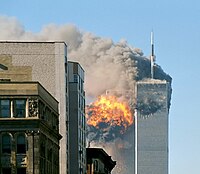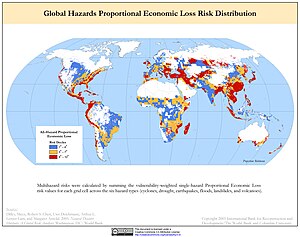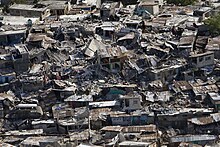
Disaster

A disaster is a serious problem occurring over a short or long period of time that causes widespread human, material, economic or environmental loss which exceeds the ability of the affected community or society to cope using its own resources. Disasters are routinely divided into either "natural disasters" caused by natural hazards or "human-instigated disasters" caused from anthropogenic hazards. However, in modern times, the divide between natural, human-made and human-accelerated disasters is difficult to draw.
Examples of natural hazards include avalanches, flooding, cold waves and heat waves, droughts, earthquakes, cyclones, landslides, lightning, tsunamis, volcanic activity, wildfires, and winter precipitation. Examples of anthropogenic hazards include criminality, civil disorder, terrorism, war, industrial hazards, engineering hazards, power outages, fire, hazards caused by transportation, and environmental hazards.
Developing countries suffer the greatest costs when a disaster hits – more than 95% of all deaths caused by hazards occur in developing countries, and losses due to natural hazards are 20 times greater (as a percentage of gross domestic product) in developing countries than in industrialized countries.
Etymology
The word disaster is derived from Middle French désastre and that from Old Italian disastrocode: ita promoted to code: it , which in turn comes from the Ancient Greek pejorative prefix δυσ- (dus-) "bad" and ἀστήρ (aster), "star". The root of the word disaster ("bad star" in Greek) comes from an astrological sense of a calamity blamed on the position of planets.
Classification

Disasters are routinely divided into natural or human-made. However, in modern times, the divide between natural, man-made and man-accelerated disasters is quite difficult to draw.
Complex disasters, where there is no single root cause, are more common in developing countries. A specific disaster may spawn a secondary disaster that increases the impact. A classic example is an earthquake that causes a tsunami, resulting in coastal flooding, resulting in damage to a nuclear power plant (such as the Fukushima nuclear disaster). Some manufactured disasters have been wrongly ascribed to nature, such as smog and acid rain.
Some researchers also differentiate between recurring events, such as seasonal flooding, and those considered unpredictable.
Natural disasters (caused by natural hazards)
A natural disaster is "the negative impact following an actual occurrence of natural hazard in the event that it significantly harms a community". A natural disaster can cause loss of life or damage property, and typically leaves some economic damage in its wake. The severity of the damage depends on the affected population's resilience and on the infrastructure available. Examples of natural hazards include: avalanche, coastal flooding, cold wave, drought, earthquake, hail, heat wave, hurricane (tropical cyclone), ice storm, landslide, lightning, riverine flooding, strong wind, tornado, typhoon, tsunami, volcanic activity, wildfire, winter weather.
In modern times, the divide between natural, human-made and human-accelerated disasters is quite difficult to draw. Human choices and activities like architecture, fire, resource management and climate change potentially play a role in causing "natural disasters". In fact, the term "natural disaster" has been called a misnomer already in 1976. A disaster is a result of a natural or human-made hazard impacting a vulnerable community. It is the combination of the hazard along with exposure of a vulnerable society that results in a disaster.
Natural disasters can be aggravated by inadequate building norms, marginalization of people, inequities, overexploitation of resources, extreme urban sprawl and climate change. The rapid growth of the world's population and its increased concentration often in hazardous environments has escalated both the frequency and severity of disasters. Extreme climates (such as those in the Tropics) and unstable landforms, coupled with deforestation, unplanned growth proliferation and non-engineered constructions create more vulnerable interfaces of populated areas with disaster-prone natural spaces. Developing countries which suffer from chronic natural disasters, often have ineffective communication systems combined with insufficient support for disaster prevention and management.Human-instigated disasters (caused by anthropogenic hazards)

Human-instigated disasters are the consequence of technological or human hazards. Examples include war, social unrest, stampedes, fires, transport accidents, industrial accidents, conflicts, oil spills, terrorist attacks, and nuclear explosions/nuclear radiation.
Other types of induced disasters include the more cosmic scenarios of catastrophic climate change, nuclear war, and bioterrorism.
One opinion argues that all disasters can be seen as human-made, due to human failure to introduce appropriate emergency management measures.
Famines may be caused locally by drought, flood, fire, or pestilence, but in modern times there is plenty of food globally, and sustained localized shortages are generally due to government mismanagement, violent conflict, or an economic system that does not distribute food where needed. Earthquakes are mainly hazardous because of human-created buildings and dams; avoiding earthquake-generated tsunamis and landslides is largely a matter of location.
Responses
Disaster management is a main function of civil protection (or civil defence) authorities and should address all of the following four phases of disasters:
Mitigation
Response
Recovery
The recovery phase starts after the immediate threat to human life has subsided. The immediate goal of the recovery phase is to bring the affected area back to normalcy as quickly as possible. During reconstruction, it is recommended to consider the location or construction material of the property.
The most extreme home confinement scenarios include war, famine, and severe epidemics and may last a year or more. Then recovery will take place inside the home. Planners for these events usually buy bulk foods and appropriate storage and preparation equipment, and eat the food as part of normal life. A simple balanced diet can be constructed from vitamin pills, whole-grain wheat, beans, dried milk, corn, and cooking oil. Vegetables, fruits, spices and meats, both prepared and fresh-gardened, are included when possible.Preparedness
By type of disaster
The following table categorizes some disasters and notes first response initiatives.
| Natural | Disaster | ||
|---|---|---|---|
| Example | Profile | First response | |
| Avalanche | The sudden, drastic flow of snow down a slope, occurring when either natural triggers, such as loading from new snow or rain, or artificial triggers, such as explosives or backcountry skiers, overload the snowpack | Shut off utilities; Evacuate building if necessary; Determine impact on the equipment and facilities and any disruption | |
| Blizzard | A severe snowstorm characterized by very strong winds and low temperatures | Power off all equipment; listen to blizzard advisories; Evacuate area, if unsafe; Assess damage | |
| Earthquake | The shaking of the earth's crust, caused by underground volcanic forces of breaking and shifting rock beneath the earth's surface | Shut off utilities; Evacuate building if necessary; Determine impact on the equipment and facilities and any disruption | |
| Fire (wild) | Fires that originate in uninhabited areas and which pose the risk to spread to inhabited areas | Attempt to suppress fire in early stages; Evacuate personnel on alarm, as necessary; Notify fire department; Shut off utilities; Monitor weather advisories | |
| Flood | Flash flooding: Small creeks, gullies, dry streambeds, ravines, culverts or even low-lying areas flood quickly | Monitor flood advisories; Determine flood potential to facilities; Pre-stage emergency power generating equipment; Assess damage | |
| Freezing rain | Rain occurring when outside surface temperature is below freezing | Monitor weather advisories; arrange for snow and ice removal | |
| Heat wave | A prolonged period of excessively hot weather relative to the usual weather pattern of an area and relative to normal temperatures for the season | Listen to weather advisories; Power-off all servers after a graceful shutdown if there is imminent potential of power failure; Shut down main electric circuit usually located in the basement or the first floor | |
| Hurricane | Heavy rains and high winds | Power off all equipment; listen to hurricane advisories; Evacuate area, if flooding is possible; Check gas, water and electrical lines for damage; Do not use telephones, in the event of severe lightning; Assess damage | |
| Landslide | Geological phenomenon which includes a range of ground movement, such as rock falls, deep failure of slopes and shallow debris flows | Shut off utilities; Evacuate building if necessary; Determine impact on the equipment and facilities and any disruption | |
| Lightning strike | An electrical discharge caused by lightning, typically during thunderstorms | Power off all equipment; listen to hurricane advisories; Evacuate area, if flooding is possible; Check gas, water and electrical lines for damage; Do not use telephones, in the event of severe lightning; Assess damage | |
| Limnic eruption | The sudden eruption of carbon dioxide from deep lake water | Shut off utilities; Evacuate building if necessary; Determine impact on the equipment and facilities and any disruption | |
| Tornado | Violent rotating columns of air which descend from severe thunderstorm cloud systems | Monitor tornado advisories; Power off equipment; Shut off utilities (power and gas); Assess damage once storm passes | |
| Tsunami | A series of waves hitting shores strongly, mainly caused by the displacement of a large volume of a body of water, typically an ocean or a large lake, usually caused by earthquakes, volcanic eruptions, underwater explosions, landslides, glacier calvings, meteorite impacts and other disturbances above or below water | Power off all equipment; listen to tsunami advisories; Evacuate area, if flooding is possible; Check gas, water and electrical lines for damage; Assess damage | |
| Volcanic eruption | The release of hot magma, volcanic ash and/or gases from a volcano | Shut off utilities; Evacuate building if necessary; Determine impact on the equipment and facilities and any disruption | |
| Human-made | Bioterrorism | The intentional release or dissemination of biological agents as a means of coercion | Get information immediately from public health officials via the news media as to the right course of action; If you think you have been exposed, quickly remove your clothing and wash off your skin; put on a HEPA to help prevent inhalation of the agent |
| Civil unrest | A disturbance caused by a group of people that may include sit-ins and other forms of obstructions, riots, sabotage and other forms of crime, and which is intended to be a demonstration to the public and the government, but can escalate into general chaos | Contact local police or law enforcement | |
| Fire (urban) | Even with strict building fire codes, people still perish in fires | Attempt to suppress fire in early stages; Evacuate personnel on alarm, as necessary; Notify fire department; Shut off utilities; Monitor weather advisories | |
| Hazardous material spills | The escape of solids, liquids, or gases that can harm people, other living organisms, property or the environment, from their intended controlled environment such as a container. | Leave the area and call the local fire department for help. If anyone was affected by the spill, call your local Emergency Medical Services line | |
| Nuclear and radiation accidents | An event involving the significant release of radioactivity to the environment or a reactor core meltdown and which leads to major undesirable consequences to people, the environment, or the facility | Recognize that a CBRN incident has or may occur. Gather, assess and disseminate all available information to first responders. Establish an overview of the affected area. Provide and obtain regular updates to and from first responders. | |
| Power failure | Caused by summer or winter storms, lightning or construction equipment digging in the wrong location | Wait 5–10 minutes; turn off all servers after a graceful shutdown; do not use telephones, in the event of severe lightning; shut down main electric circuit usually located in the basement or the first floor | |
See also
- Act of God
- Catastrophic failure
- Disaster convergence
- Disaster medicine
- Disaster recovery
- Disaster recovery and business continuity auditing
- Disaster recovery plan
- Disaster research
- Disaster response
- Emergency management
- Environmental emergency
- Human extinction
- List of accidents and disasters by death toll
- Lists of disasters
- Opportunism
- Sociology of disaster
Further reading
- Barton, Allen H. Communities in Disaster: A Sociological Analysis of Collective Stress Situations, Doubleday, 1st edition 1969, ASIN: B0006BVVOW
- Susanna M. Hoffman, Susanna M. & Anthony Oliver-Smith, authors & editors. Catastrophe and Culture: The Anthropology of Disaster, School of American Research Press, 1st edition 2002, ISBN 978-1930618152
- Bankoff, Greg, Georg Frerks, Dorothea Hilhorst. Mapping Vulnerability: Disasters, Development and People, Routledge, 2004, ISBN 978-1853839641
- Alexander, David. Principles of Emergency planning and Management, Oxford University Press, 1 edition 2002, ISBN 978-0195218381
- Quarantelli, E. L. (2008). "Conventional Beliefs and Counterintuitive Realities". Conventional Beliefs and Counterintuitive Realities in Social Research: an international Quarterly of the social Sciences, Vol. 75 (3): 873–904.
- Paul, B. K et al. (2003). "Public Response to Tornado Warnings: a comparative Study of the 4 May 2003 Tornadoes in Kansas, Missouri and Tennessee". Quick Response Research Report, no 165, Natural Hazard Center, Universidad of Colorado
- Kahneman, D. y Tversky, A. (1984). "Choices, Values and frames". American Psychologist 39 (4): 341–350.
- Beck, U. (2006). Risk Society, towards a new modernity. Buenos Aires, Paidos
- Aguirre, B. E & Quarantelli, E. H. (2008). "Phenomenology of Death Counts in Disasters: the invisible dead in the 9/11 WTC attack". International Journal of Mass Emergencies and Disasters. Vol. 26 (1): 19–39.
- Wilson, H. (2010). "Divine Sovereignty and The Global Climate Change debate". Essays in Philosophy. Vol. 11 (1): 1–7
- Uscher-Pines, L. (2009). "Health effects of Relocation following disasters: a systematic review of literature". Disasters. Vol. 33 (1): 1–22.
- Scheper-Hughes, N. (2005). "Katrina: the disaster and its doubles". Anthropology Today. Vol. 21 (6).
- Phillips, B. D. (2005). "Disaster as a Discipline: The Status of Emergency Management Education in the US". International Journal of Mass-Emergencies and Disasters. Vol. 23 (1): 111–140.
- Mileti, D. and Fitzpatrick, C. (1992). "The causal sequence of Risk communication in the Parkfield Earthquake Prediction experiment". Risk Analysis. Vol. 12: 393–400.
- Perkins, Jamey. "The Calamity of Disaster – Recognizing the possibilities, planning for the event, managing crisis and coping with the effects", Public Safety Degrees
External links
- International Federation of Red Cross and Red Crescent Societies – IFRC
- ReliefWeb of the United Nations Office for the Coordination of Humanitarian Affairs –ReliefWeb
- United Nations Office for Disaster Risk Reduction – UNDRR
- EM-DAT International Disaster Database of the Centre for Research on the Epidemiology of Disasters
- Global Disaster Alert and Coordination System – a joint initiative of the United Nations Office for the Coordination of Humanitarian Affairs (OCHA) and the European Commission
- UN-SPIDER – UN-SPIDER, the United Nations Platform for Space-based Information for Disaster Management and Emergency Response], a project of the United Nations Office for Outer Space Affairs (UNOOSA)
| Overview | |||||||||||||||||||||||||||||||||||||||||||||
|---|---|---|---|---|---|---|---|---|---|---|---|---|---|---|---|---|---|---|---|---|---|---|---|---|---|---|---|---|---|---|---|---|---|---|---|---|---|---|---|---|---|---|---|---|---|
| Disasters |
|
||||||||||||||||||||||||||||||||||||||||||||
| Preparation | |||||||||||||||||||||||||||||||||||||||||||||
| Countermeasures | |||||||||||||||||||||||||||||||||||||||||||||
| Media | |||||||||||||||||||||||||||||||||||||||||||||
| Organizations | |||||||||||||||||||||||||||||||||||||||||||||
| National | |
|---|---|
| Other | |


